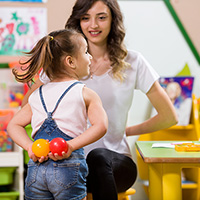How Do I Reinforce My Child's Applied Behaviour Analysis (ABA) Therapy at Home?
The main goal of Applied Behaviour Analysis (ABA) is to generalise the skills and behaviours learned during ABA therapy. This can enhance the child’s ability to adapt to different situations, settings and people and foster greater independence. And where better to learn outside of the ABA sessions than in the comfort of home?
Role of Parents and Caregivers to Reinforce Their Child’s ABA Programme
In ABA, parents and primary caregivers play a key role in a child’s learning and development. The love, support, encouragement and active participation of parents and caregivers are crucial in helping the child reinforce learning, make significant and lasting improvements and enjoy a positive learning experience.
By getting involved in the entire learning process, parents and caregivers not only contribute to reinforcing the child’s learning at home, but they also learn how ABA therapy is carried out and feel like they are part of their child’s learning journey. This may invariably boost the child’s progress and speed in achieving the desired outcomes.
ABA practitioners understand the benefits of the parents and caregivers’ role and will seek to establish partnerships with these key stakeholders and guide and support them in carrying out the right strategies at home through appropriate parent training, provision of valuable resources and information, and more.

ABA in a Nutshell
For over 50 years, ABA has been efficacious for individuals of all ages. This intensive form of therapy is also one of the more widely used interventions for children with various developmental and behavioural delays and/or challenges, which includes children with Autism Spectrum Disorders (ASD). Children as young as 2 years old who are showing signs of developmental delays or have been diagnosed can receive individualised ABA therapy, which will be carried out one-on-one by Behaviour Therapists.
In addition to generalising learning, ABA increases good behaviours, decreases dysfunctional ones and teaches new and replacement skills through the use of reinforcements and rewards. What is reinforcement and is it the same as bribery or punishment? We will explain more later in this article.
Types of ABA Strategies and Activities to Adapt at Home
Every child needs to be aware of the consequences, good or bad, of their actions or behaviours regardless of where they are or who they interact with. There are various ways to deal with behaviours, and which one to use will depend on the types of behaviour demonstrated.
The good thing about applying simple ABA techniques at home is that it does not require any complicated tools or equipment to be carried out effectively. All you need is the know-how, consistency and everyday objects.
In the management of behaviours, the important thing is to be consistent at any given time. Whether during sessions, at home or school, how a particular behaviour is addressed and reinforced by the adults should remain the same to ensure the child remembers and learns effectively.
Before you apply ABA techniques at home, there are some important considerations to bear in mind:
- The goal of ABA is to improve skills and behaviours. This should be the learning objective to keep in mind throughout.
- What are your child’s current skill level and learning ability? If your child is not mentally or developmentally ready for certain tasks, it is good to ensure that your child’s ABA therapist first work on strengthening the prerequisite skills needed for those tasks. The therapist may help break those tasks down into simpler sub-steps so that your child is able to acquire and enhance the required skills easily.
- What are your child’s areas of deficit and defined programme goals to bridge developmental gaps? Check or work with your child’s ABA therapist to reinforce what has been learned. ABA programmes are usually structured and time will be spent on gradually developing the skills required.

Here are some tips to help you get prepared:
- Ensure that every task is kept simple with clear instructions that are easy to understand and follow. You may have to break a task down into many easy-to-follow sequential tasks, guiding your child in every little task that needs to be completed.
- Reinforcers. Understand what your child is motivated by and how using these incentives can help in the completion of tasks willingly and independently.
- Be generous with praises and encouragements for your child.
- Learning aids (printed out or DIY). You do not have to use any fancy tools; simple templates customised to your child’s needs would work well.
- Visual support. Vibrant visuals can be useful in showing (or prompting) the sequence of steps to achieve a task. You can find templates online or your ABA practitioner can help customise them to your child’s needs and level of understanding.
- Prompt through tasks, starting intensively and gradually fading off systematically to promote independence. Your child’s ABA practitioner can guide you in this process.
Do discuss your ideas and plans with your child’s ABA practitioner, and get their advice on what would work for your child. If your child is not seeing an ABA Therapist currently, you can still carry out these simple activities, but bearing in mind the above considerations to ensure smooth and effective learning.
In the next section, we list some ABA skills and activities that you can easily implement at home. This is a guide since every child is different in needs, temperament, motivation and learning pace. We recommended tailoring these to your child’s uniqueness – and remember to have fun!
- In-Seat Behaviour
It is good to set clear contingencies and expectations about what the child will earn for sitting still and working. - Schedule. Create a schedule so that your child understands what is expected of them and what reward (a break of their choice) they get once they have completed their tasks as indicated in the schedule. At the start, you can reward your child even if they can sit for only a short duration. Rewards can be in the form of giving access to preferred toys/activities and/or verbal praises. You can then gradually increase the duration by rewarding the child for the increased duration.
- Timers. A timer, acting as a cue and reminder, lets your child know what is the expected sitting time.
- Tokens: Tokens collected for good sitting and working can be exchanged for a reward.
- Items and Their Functions
You can create or print out a deck of flashcards that show the different household items. You can ask your child to point out the items shown on the flashcard. At the same time, you can explain the function of the item, in simple terms. - Colours
This activity helps your child learn about colours and identify them correctly. You can use a favourite toy or item and an object that has the same colour. Ask your child to match these items. You can repeat this activity using other colours. - Shapes
Your child can learn about the various shapes through drawing or objects with a particular shape. It is good to focus on one shape at a time to avoid confusing your child. - Body Parts and Their Functions
Sing songs that teach about body parts and functions. You can come up with your action songs or find related songs that encourage participation and movements. Best of all, gather the whole family to sing these songs for some fun family time and bonding. You can also indicate or label body parts in front of a mirror. - Attention and Eye Contact Skill
Do something funny or distracting to get your child to look at you and maintain eye contact. You can accompany the action with a simple instruction, such as “look at me”, that should be repeated throughout this activity. You can also try putting an item that your child likes near your eye and give the item to your child the moment they look at you. This way, your child learns to look at you to get access to the things they like. Reward your child whenever they maintain eye contact with you and gradually increase the duration of the eye contact.

The Use of Reinforcements in ABA
You may have heard the word ‘reinforcement’ used by your ABA practitioner throughout your child’s programme. So, what is reinforcement and why is it one of the key tools in ABA therapy?
Reinforcement can be anything used to control the consequences of specific actions. Reinforcements, such as tangible rewards, can shape desirable behaviours by reinforcing and increasing the frequency of the appropriate behaviours exhibited; while inappropriate behaviours are reduced through the use of consequences, such as time out, negative token economy system, etc.
Reinforcement, in the ABA context, can refer to both positive and negative reinforcements. Many parents have asked if positive reinforcement is the same as bribery or if negative reinforcement is a form of punishment. Here, we delve into what these terms are.
Positive Reinforcement vs. Bribery
Positive reinforcement is used when the child’s preferred item is presented immediately after the child exhibited an appropriate behaviour. This increases the likelihood of the desired behaviour occurring again in the future. For example, Mandy’s father gave her a lollipop for sitting nicely on the chair and completing her homework. In this scenario, the reinforcer was only given when the appropriate behaviour has already occurred. Through this, Mandy learned that to earn the lollipop (reinforcer), she would have to sit on the chair to complete her homework.
Bribery, however, is used when a child’s preferred item or activity is presented to stop an inappropriate/undesirable behaviour after the child has exhibited the behaviour. For example, Mandy is flopping around and throwing a tantrum when her father tells her that he will give her a lollipop if she sits nicely on the chair. In this scenario, inappropriate behaviour has already occurred and Mandy learned that to get a lollipop, all she has to do is flop around and throw a tantrum.
Bribery may stop the negative behaviour at that moment, but over time, the child will learn that engaging in negative behaviours helps them get what they want, thus shaping negative patterns of behaviour.
Negative Reinforcement vs. Punishment
Negative reinforcement removes the undesirable stimulus to strengthen positive behaviour. This decreases the likelihood of undesirable behaviour occurring again in the future. Unlike punishment, negative reinforcement is always applied to increase desirable behaviour. For example, Mandy’s father told her that she can leave the study table if she sits nicely and completes her homework. Through this, Mandy learned that she would have to sit on the chair and complete her homework before she can leave the study table (undesirable stimulus).
Punishment, on the other hand, is either applying or adding an undesirable stimulus or taking away a desirable stimulus to stop negative behaviour. Usually, when punishment is exacted, a consequence immediately follows a negative behaviour, which decreases the future occurrences of this particular behaviour. For example, Mandy was walking around instead of sitting still on her chair to complete her homework as instructed by her father. Her father told her that she will not be getting any lollipops until she sits nicely.
Conclusion
There may, understandably, be moments of frustration during the learning process. If either you or your child is feeling stressed or frustrated, give your child a short break and resume the activity when your child is more prepared and open to learning. Importantly, have fun with each other throughout to ensure a positive learning and bonding experience for both you and your child.
About Dynamics Behaviour Analysis
Our dedicated ABA professionals at Dynamics Behaviour Analysis collectively have a wealth of experience in working with children and adults from various countries and have been trained and worked with some of the best in ABA.
We are committed to using best practices and research-based intervention strategies and procedures, providing personalised and data-driven programmes and care, and actively partnering with parents and caregivers to help every child reach their full potential, enjoy a positive learning experience and achieve their goals.
We also provide seamless and hassle-free integrated care and support by collaborating with other highly qualified and experienced healthcare professionals of Dynamics Therapy Group’ in-house multidisciplinary team, such as Occupational Therapists, Speech Therapists, Physiotherapists, Counsellors, Education Therapists, and more.


